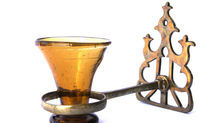From Secular to Ceremonial Art
- Shira Batalin
- Sep 2, 2022
- 1 min read
While wandering through a small antique shop in a northern town in Scotland, my eye was caught by what appeared to be an Etrog container. Although the container was not decorated with inscriptions in Hebrew and did not carry other Jewish visual characteristic, its size and the presence of the lid were accurate for the protection of the Etrog and particularly, its stem, which must remain intact during the entire holiday of Sukkot.
Although the representation of the Etrog is as early as the Maccabean period, actual containers for the Etrog are a rather late development. The containers appear in many forms, amongst them ovoid, cylindrical, and rectangular containers, ranging in style from extreme simplicity to great splendor.
Though several ritual objects, such as Hanukkah lamps and Kiddush cups, were prescribed for the proper observation of Jewish ceremonies, Jewish law gave only minimal instruction as to their form. As a result, Jews often employed objects for religious rituals that might otherwise find a place in a Christian home, and recognizable, distinctive Jewish ceremonial objects evolved only gradually. For example, wine goblets or vodka beakers have become Kiddush cups for blessing wine on Sabbaths and holy days, and covered storage jars have become Etrog containers.

































Comments